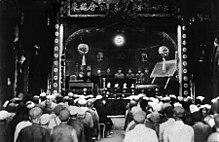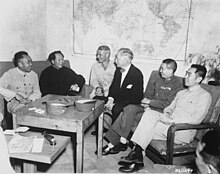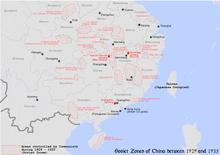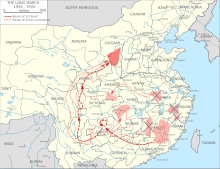
The Chinese Civil War was fought between the Kuomintang-led government of the Republic of China and the forces of the Chinese Communist Party (CCP), with armed conflict continuing intermittently from 1 August 1927 until 7 December 1949, resulting in a CCP victory and control of mainland China in the Chinese Communist Revolution.

The Long March was a military retreat by the Chinese Red Army from advancing Nationalist forces during the Chinese Civil War in 1934 through 1936.
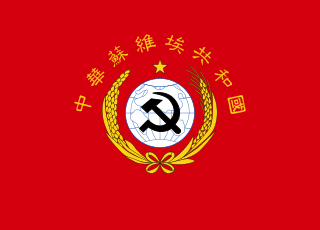
The Chinese Soviet Republic (CSR) was a state within China, proclaimed on 7 November 1931 by Chinese Communist Party (CCP) leaders Mao Zedong and Zhu De in the early stages of the Chinese Civil War. The discontiguous territories of the CSR included 18 provinces and 4 counties under the communists' control. The CSR's government was located in its largest component territory, the Jiangxi Soviet. Due to the importance of the Jiangxi Soviet in the CSR's early history, the name "Jiangxi Soviet" is sometimes used to refer to the CSR as a whole. Other component territories of the CSR included the Northeastern Jiangxi, Hunan-Jiangxi, Hunan-Hubei-Jiangxi, Hunan-Western Hubei, Hunan-Hubei-Sichuan-Guizhou, Eyuwan, Shaanxi-Gansu, Sichuan-Shanxi, and Haifeng-Lufeng Soviets.
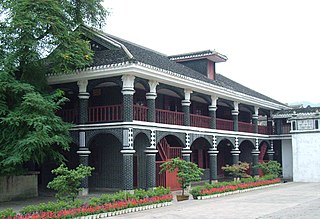
The Zunyi Conference was a meeting of the Chinese Communist Party (CCP) in January 1935 during the Long March. This meeting involved a power struggle between the leadership of Bo Gu and Otto Braun and the opposition led by Mao Zedong. The result was that Mao left the meeting in position to take over military command and become the leader of the Communist Party. The conference was completely unacknowledged until the 1950s and still no detailed descriptions were available until the fiftieth anniversary in 1985.

He Long was a Chinese Communist revolutionary and a Marshal of the People's Republic of China. He was from a poor rural family in Hunan, and his family was not able to provide him with any formal education. He began his revolutionary career after avenging the death of his uncle, when he fled to become an outlaw and attracted a small personal army around him. Later his forces joined the Kuomintang, and he participated in the Northern Expedition.
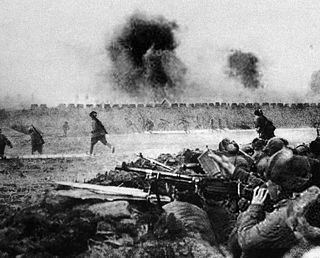
The Liaoshen campaign, an abbreviation of Liaoning–Shenyang campaign after the province of Liaoning and its Yuan directly administered capital city Shenyang, was the first of the three major military campaigns launched by the Communist People's Liberation Army (PLA) against the Kuomintang Nationalist government during the late stage of the Chinese Civil War. This engagement is also known to the Kuomintang as the Liaohsi campaign, and took place between September and November 1948, lasting a total of 52 days. The campaign ended after the Nationalist forces suffered sweeping defeats across Manchuria, losing the major cities of Jinzhou, Changchun, and eventually Shenyang in the process, leading to the capture of the whole of Manchuria by the Communist forces. The victory of the campaign resulted in the Communists achieving a strategic numerical advantage over the Nationalists for the first time in its history.

The Second United Front was the alliance between the ruling Kuomintang (KMT) and the Chinese Communist Party (CCP) to resist the Japanese invasion of China during the Second Sino-Japanese War, which suspended the Chinese Civil War from 1937 to 1945.

The Shanghai massacre of 12 April 1927, the April 12 Purge or the April 12 Incident as it is commonly known in China, was the violent suppression of Chinese Communist Party (CCP) organizations and leftist elements in Shanghai by forces supporting General Chiang Kai-shek and conservative factions in the Kuomintang. Following the incident, conservative KMT elements carried out a full-scale purge of communists in all areas under their control, and violent suppression occurred in Guangzhou and Changsha. The purge led to an open split between left-wing and right-wing factions in the KMT, with Chiang Kai-shek establishing himself as the leader of the right-wing faction based in Nanjing, in opposition to the original left-wing KMT government based in Wuhan, which was led by Wang Jingwei. By 15 July 1927, the Wuhan regime had expelled the Communists in its ranks, effectively ending the First United Front, a working alliance of both the KMT and CCP under the tutelage of Comintern agents. For the rest of 1927, the CCP would fight to regain power, beginning the Autumn Harvest Uprising. With the failure and the crushing of the Guangzhou Uprising at Guangzhou however, the power of the Communists was largely diminished, unable to launch another major urban offensive.

Mo Xiong was born in Yingde, Guangdong and was a close friend of Sun Yat-sen, and member of Tongmenghui, a member of Kuomintang, and a communist sympathizer / agent. He served high ranking positions in both the Republic of China and the People's Republic of China. In both Mao Zedong's and Zhou Enlai's words, Mo Xiong had saved the Chinese Communist Party and the Chinese revolution in 1934 when he provided important intelligence on Chiang Kai-shek's military plans, and thus saved the Communists from total annihilation.
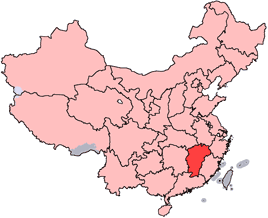
The second encirclement campaignagainst Jiangxi Soviet was a series of battles launched by the Chinese Nationalist Government in the hope of encircling and destroying the Jiangxi Soviet after the previous campaign had failed. The Red Army repelled the encirclement by launching their second counter-encirclement campaign, also called by the communists as the second counter-encirclement campaign at Central Revolutionary Base, in which the local Chinese Red Army successfully defended the Jiangxi Soviet against the Nationalist attacks from April 1, 1931, to May 31, 1931.

The third encirclement campaignagainst Jiangxi Soviet was the third campaign launched by the Chinese Nationalist Government in the hope of destroying the Red Army in Jiangxi. It was launched less than a month after the previous campaign failed. However, this encirclement was repelled by the Red Army's third counter-encirclement campaign at the Central Soviet, also called as the third counter-encirclement campaign at the Central Revolutionary Base.

The Jiangxi Soviet was a soviet governed by the Chinese Communist Party (CCP) that existed between 1931 and 1934. It was the largest component of the Chinese Soviet Republic and home to its capital, Ruijin. At the time, the CCP was engaged in a rural insurgency against the Kuomintang-controlled Nationalist Government as part of the Chinese Civil War. CCP leaders Mao Zedong and Zhu De chose to create the soviet in the rugged Jinggang Mountains on the border of Jiangxi and Fujian because of its remote location and defensible terrain. The First Red Front Army successfully repulsed a series of encirclement campaigns by the Kuomintang's National Revolutionary Army (NRA) during the first few years of the Soviet's existence, but they were eventually defeated by the NRA's fifth attempt in 1934-35. After the Jiangxi Soviet was defeated militarily, the CCP began the Long March towards a new base area in the northwest.

The Northeastern Jiangxi Soviet, first known as the Xin River Soviet and later as the Minzhegan Soviet, was a soviet governed by the Chinese Communist Party (CCP) that existed between 1928 and 1934 as part of the Chinese Soviet Republic. The core of the Soviet included the counties of Chong'an in Fujian, Kaihua in Zhejiang, Wuyuan in Anhui, and Yiyang and Hengfeng in Jiangxi. It was founded and led for much of its existence by Fang Zhimin and was the base of the Tenth Red Army.

The fifth encirclement campaign against the Jiangxi Soviet was a series of battles fought during the Chinese Civil War from 25 September 1933, to October 1934 between Chiang Kai-shek's Chinese Nationalists (Kuomintang) and the Chinese Communists. During this campaign, the Kuomintang successfully overran the communist Chinese Soviet Republic and forced the Communists on the run, an event later known as the Long March.
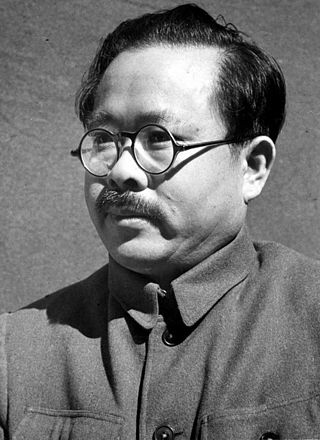
Ren Bishi was a military and political leader in the early Chinese Communist Party (CCP).

The Chinese Communist Revolution was a social and political revolution that culminated in the establishment of the People's Republic of China (PRC) in 1949. For the preceding century, China had faced escalating social, economic, and political problems as a result of Western imperialism, Japanese imperialism, and the decline of the Qing dynasty. Cyclical famines and an oppressive landlord system kept the large mass of rural peasantry poor and politically disenfranchised. The Chinese Communist Party (CCP) was formed in 1921 by young urban intellectuals inspired by European socialist ideas and the success of the October Revolution in Russia. The CCP originally allied itself with the nationalist Kuomintang (KMT) party against the warlords and foreign imperialist forces, but the 1927 massacre of Communists in Shanghai ordered by Kuomintang leader Chiang Kai-shek forced them into the Chinese Civil War, which would last more than two decades.

The Chongqing Negotiations were a series of negotiations between the Kuomintang-ruled Nationalist government and the Chinese Communist Party (CCP) from 29 August to 10 October 1945, held in Chongqing, China. The negotiations were highlighted by the final meeting between the leaders of both parties, Chiang Kai-shek and Mao Zedong, which was the first time they had met in 20 years. Most of the negotiations were undertaken by Wang Shijie and Zhou Enlai, representatives of the Nationalist government and CCP, respectively. The negotiations lasted for 43 days, and came to a conclusion after both parties signed the Double Tenth Agreement.

The retreat of the government of Republic of China to Taiwan, also known as the Kuomintang's retreat to Taiwan or the Great Retreat in Taiwan, refers to the exodus of the remnants of the then-internationally-recognized Kuomintang-ruled government of the Republic of China (ROC) to the island of Taiwan (Formosa) on December 7, 1949, after losing the Chinese Civil War in the Chinese mainland. The Kuomintang, its officers, and approximately 2 million ROC troops took part in the retreat, in addition to many civilians and refugees, fleeing the advance of the People's Liberation Army of the Chinese Communist Party (CCP). The CCP, who now effectively controlled most of Mainland China, spent the subsequent years purging any remnant Nationalist agents and bandits in western and southern China, solidifying the rule of the newly established People's Republic of China.
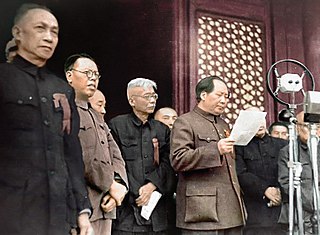
The proclamation of the People's Republic of China was made by Mao Zedong, the Chairman of the Chinese Communist Party (CCP), on October 1, 1949, in Tiananmen Square in Beijing. The government of a new state under the CCP, formally called the Central People's Government, was proclaimed by Mao at the ceremony, which marked the foundation of the People's Republic of China.

The Battle of Chishui River, popularly known in mainland China as the Four Crossings of the Chishui River or "Crossing the Chishui River Four Times" (四渡赤水), was a major battle between the Chinese Communist Party (CCP) and the Chinese Nationalist Party (KMT) in 1935. It was the first major battle commanded by Mao Zedong during the Long March, and it is regarded as one of the most representative battles under Mao's command. This battle was a turning point in the first phase of Chinese Civil War. The Chinese Red Army jumped out of the encirclement of Kuomintang by unexpectedly crossing the Chishui River four times, and eventually survived the anti-communist military campaign of Chiang Kai-shek.





